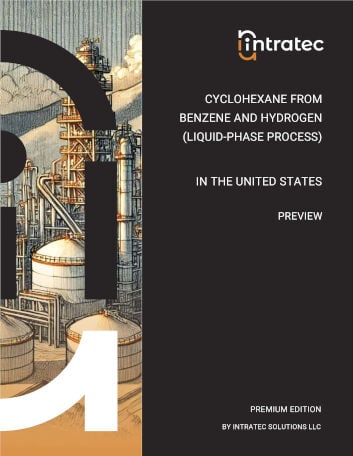Commodity Production Costs Report
KA Oil Production
KA Oil Plant Capital & Operating Cost Analysis | United States | Q3 2025
This report presents the economics of KA oil production from cyclohexane. The process examined is similar to the one developed by Invista. In this process, cyclohexane is initially oxidized with air to produce a mixture of cyclohexanone and cyclohexanol (also referred to as ketone-alcohol oil - KA oil).
The report provides a comprehensive study of KA Oil production and related KA Oil production cost, covering three key aspects: a complete description of the KA Oil production process examined; an in-depth analysis of the related KA Oil plant capital cost (Capex); and an evaluation of the respective KA Oil plant operating costs (Opex).
The KA Oil production process description includes a block flow diagram (BFD), an overview of the industrial site installations, detailing both the process unit and the necessary infrastructure, process consumption figures and comprehensive process flow diagrams (PFD). The KA Oil plant capital cost analysis breaks down the Capex by plant cost (i.e., ISBL, OSBL and Contingency); owner's cost; working capital; and costs incurred during industrial plant commissioning and start-up. The KA Oil plant operating costs analysis covers operating expenses, including variable costs like raw materials and utilities, and fixed costs such as maintenance, labor, and depreciation.

The process under analysis comprises two major sections: (1) Oxidation; and (2) Purification.
Oxidation. Initially, cyclohexane is fed to the first of several staged air oxidation vessels, along with meta-boric acid. The cyclohexane is oxidized in the liquid-phase to cyclohexyl hydroperoxide (CHHP). In the presence of boric acid, the cyclohexyl hydroperoxide is trapped as cyclohexyl perborate ester, which in turn reacts with cyclohexane yielding borate ester and cyclohexanol. The borate ester formed is relatively stable, in such a way that the generation of undesired by-products is minimized. Next, the ester is hydrolyzed, yielding cyclohexanol and boric acid, in organic and aqueous phases, respectively. Subsequently, CHHP still present in the oxidation product is decomposed by another oxidation reaction over a fixed bed of cobalt catalysts, yielding a cyclohexanol-cyclohexanone mixture (KA oil). The boric acid present in the aqueous phase is crystallized, dehydrated, and recycled to the first oxidation reactor.
Purification. The organic effluent from CHHP oxidation goes through a series of purification steps. First, unreacted cyclohexane is stripped and recovered. Second, heavy ends are removed via distillation to be used as fuel, yielding the refined KA Oil product.
Report in PDF Format
Download & Explore Anytime
Access in Various Devices
Print & Read Comfortably
Share With Co-workers
Up-to-date Report
Professional report based on Q3 2025 economic data, ensuring timely evaluations.
Multiple Use Cases
Ideal for investment screening, feasibility studies, cost estimates, and research planning.
Proven Methodology
Developed using a consistent methodology honed over a decade, ensuring reliable cost analyses.
Report Editions
Content Highlights
Plant Capital Cost Summary
Summary outlining the capital cost required for building the KA Oil production plant examined.
Plant Capital Cost Details
Detailing of fixed capital (ISBL, OSBL & Owner’s Cost), working capital and additional capital requirements.
Plant Cost Breakdowns
Breakdown of KA Oil process unit (ISBL) costs and infrastructure (OSBL) costs; plant cost breakdown per discipline.
Operating Costs Summary
Summary presenting the operating variable costs and the total operating cost of the KA Oil production plant studied.
Operating Cost Details
Detailing of utilities costs, operating fixed costs and depreciation.
Plant Capacity Assessment
Comparative analysis of capital investment and operating costs for different KA Oil plant capacities.
Production Process Information
Block Flow Diagram, descriptions of process unit (ISBL) and site infrastructure (OSBL).
Process Consumptions
Raw materials and utilities consumption figures, by-products credits, labor requirements
Process Diagrams
Process flow diagrams (PFD), equipment list and industrial site configuration
Could Not Find the Report You Need?
Obtain a Bespoke Report
Get a report targeting the process in which you are interested
See Offer Details
Understand Bespoke Reports and how you can easily order them
Check Editions & Pricing
Complete a brief form and see a quotation for your Bespoke Report
Other Related Production Cost Reports

Cyclohexane from Benzene and Hydrogen (Vapor-Phase Process)
This feasibility study shows the economics of Cyclohexane production from benzene using a vapor phase hydrogenation process in the presence of a nickel-based catalyst. The economic analysis presented is based on a plant constructed in the United States.
Details: 200 kta United States-based plant | Q3 2025 | 107 pages | Issue B | From

Adipic Acid Production from KA Oil
This report presents the economics of Adipic Acid production from a mixture of cyclohexanone and cyclohexanol (known as KA oil) in the United States. The process portrayed comprises the oxidation of the KA oil with nitric acid to produce Adipic Acid. A mixture of adipic, glutaric, and succinic acids is generated as by-product.
Details: 350 kta United States-based plant | Q3 2025 | 107 pages | Issue J | From

Cyclohexane from Benzene and Hydrogen (Liquid-Phase Process)
This feasibility study shows the economics of Cyclohexane production from benzene using a liquid phase hydrogenation process in the presence of a nickel-based catalyst. The economic analysis presented is based on a plant constructed in the United States.
Details: 200 kta United States-based plant | Q3 2025 | 107 pages | Issue A | From
+800 Reports Developed, Targeting +250 Commodities
Vast Report Library
858 independent and up-to-date reports examining embryonic and established production processes.
Free Sample Reports
Quickly understand the structure and depth of content of our professional reports.

